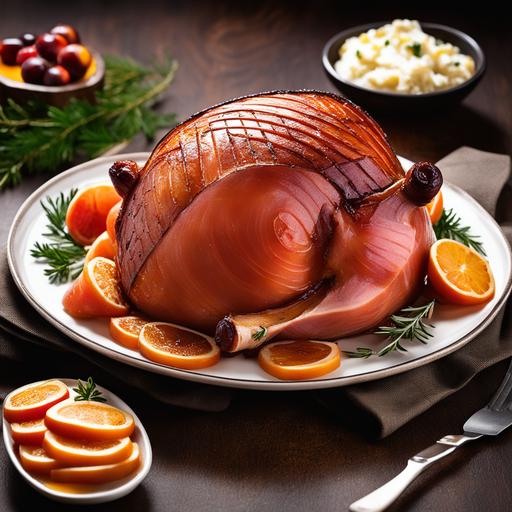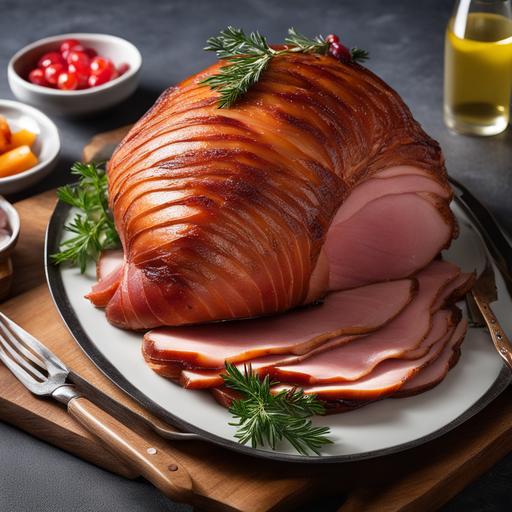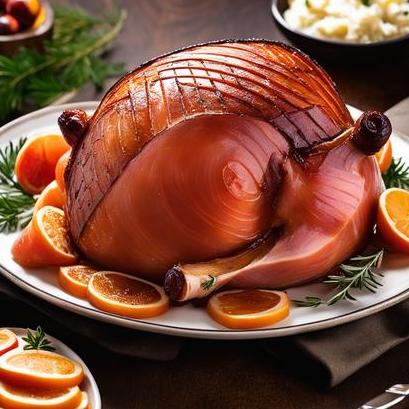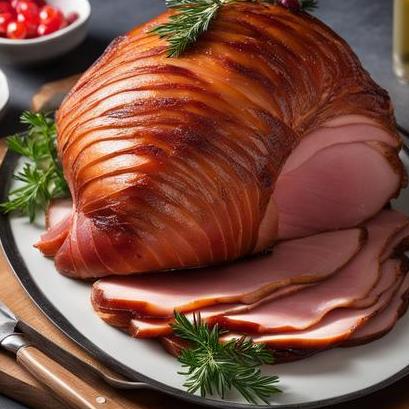
Preparing The Perfect Glazed Ham In The Oven: A Comprehensive Guide
Indulging in a succulent, glazed ham is one of life’s true culinary pleasures. The tantalizing aroma, combined with the tender meat and sweet glaze, makes for a delectable feast that is guaranteed to delight your taste buds. In this comprehensive guide, we will delve into the science of cooking a glazed ham in the oven, exploring every aspect from selection to serving. Get ready to embark on a flavorsome journey filled with knowledge, tips, and scrumptious variations.
Understanding the Science behind Glazed Hams
Before we dive into the specifics of preparing a glazed ham, let’s explore the science behind this mouthwatering dish. The magic lies in the unique combination of flavors and textures that make up the perfect glazed ham:
-
Curing Process: The first step in creating a succulent glazed ham is the curing process. This involves preserving the meat, usually a cut from the pig’s hind leg, through salting or brining. Curing enhances the ham’s flavor, texture, and shelf life.
-
Maillard Reaction: As the ham bakes in the oven, a chemical reaction known as the Maillard reaction occurs. This process involves the interaction of amino acids and reducing sugars present in the ham. The result is a desirable brown crust and a range of complex flavors.
-
Glaze Creation: The glaze, a perfect balance of sweet and savory, plays a vital role in enhancing the overall flavor profile of the ham. Its ingredients, such as honey, brown sugar, or maple syrup, add depth and caramelization during cooking.
Now that we have a basic understanding of the science involved, let’s move on to selecting the perfect ham for your culinary masterpiece.
Selecting the Ideal Ham
Choosing the right ham is crucial to achieve the desired result. Here are some key factors to consider when making your selection:
-
Type of Ham: There are various types of hams available, including fully cooked, partially cooked, and uncooked. For convenience, many prefer purchasing fully cooked hams, as they require less cooking time. However, if you desire more control over the cooking process and a chance to infuse your flavors, opt for a partially cooked or uncooked ham.
-
Freshness and Quality: To ensure the best taste and texture, look for a ham with a supple, moist appearance, and marbled fat. Freshness is crucial; therefore, always check the expiration date and opt for premium, well-packaged hams.
Once you have found the perfect ham, it is essential to prepare it adequately before cooking.
Cleaning and Preparation

-
Cleaning the Ham: Start by rinsing the ham under cold water to remove any excess brine or curing solution. Gently pat it dry with paper towels.
-
Trimming the Ham: Trim any excessive fat layers on the ham, leaving a thin layer intact to enhance flavor and moisture. Score the remaining fat in a diamond pattern, allowing the glaze to penetrate and create decorative marks.
With the ham cleaned and trimmed, it’s time to move on to some essential tips and variations to elevate your glazed ham to perfection.
Tips and Variations for a Heavenly Glazed Ham

-
Infusing Flavors: Create a flavorful brine by combining ingredients like apple cider, brown sugar, and spices. Allow the ham to soak in this mixture for a few hours or overnight in the refrigerator. This step enhances tenderness and introduces unique flavors.
-
Experimenting with Glazes: While a classic brown sugar and mustard glaze is always a crowd-pleaser, don’t hesitate to get creative. Try incorporating ingredients such as pineapple juice, bourbon, or even a touch of chipotle for a delightful twist.
-
Using Aromatics: Elevate the aroma and flavors by adding aromatic elements. Stud the ham with cloves, insert garlic cloves into slits, or include herbs like rosemary or thyme during cooking. These nuances will infuse the meat, creating an enticing aroma.
With these tips in mind, let’s move on to the heart of the article – the recipe for a show-stopping glazed ham cooked to perfection.
The Perfect Glazed Ham Recipe

Ingredients:
-
1 fully cooked bone-in ham (8-10 pounds)
-
1 cup of brown sugar
-
1/2 cup of maple syrup
-
1/4 cup of Dijon mustard
-
1 tablespoon of apple cider vinegar
-
Cloves for studding
-
Aromatic herbs (e.g., rosemary or thyme) for garnish
Instructions:
-
Preheat the oven to 325°F (165°C). Line a roasting pan with foil for easy cleanup.
-
Place the ham on a cutting board and gently score the fat in a diamond pattern.
-
Insert cloves into the ham at the intersections of the scored lines, evenly spacing them.
-
In a small bowl, whisk together the brown sugar, maple syrup, Dijon mustard, and apple cider vinegar to create the glaze.
-
Generously brush the glaze all over the ham, ensuring it seeps into the scored lines.
-
Place the ham, flat side down, on the prepared roasting pan and cover with foil.
-
Bake the ham in the preheated oven according to the weight. On average, allow for 15-18 minutes per pound, or until the internal temperature reaches 140°F (60°C). Periodically baste the ham with the drippings to keep it moist and flavorful.
-
Once the ham reaches the desired temperature, remove it from the oven and let it rest for 10-15 minutes. The internal temperature will continue to rise slightly during this time.
-
Garnish the glazed ham with fresh aromatic herbs of your choice before serving.
Checking for Doneness – Avoiding Undercooking or Overcooking

To achieve the perfect doneness for your glazed ham, it is important to get acquainted with internal temperature guidelines and utilize a reliable meat thermometer. Here are some key points to remember:
-
Undercooked Ham: An undercooked ham poses a health risk due to potentially harmful bacteria, so it is crucial to cook it thoroughly. The minimum internal temperature for a fully cooked ham should reach 140°F (60°C). For partially cooked or uncooked hams, aim for an internal temperature of 160°F (71°C).
-
Overcooked Ham: Overcooking a ham can result in a dry and tough texture. Avoid this by monitoring the internal temperature and removing the ham from the oven as soon as it reaches the desired doneness. The resting period will allow the carryover cooking to complete the process without overcooking the meat.
By following these guidelines, you can enjoy a moist and succulent glazed ham every time.
Serving and Storing the Glazed Ham
Once your glazed ham has reached perfection, it’s time to savor the flavors you’ve worked so diligently to achieve. Serve the ham as the centerpiece of your holiday feast or any special occasion. Pair it with traditional sides like scalloped potatoes or roasted vegetables for a well-rounded meal.
Note: To store any leftovers, wrap the ham tightly with foil or place it in an airtight container in the refrigerator. Leftover ham can be used in sandwiches, soups, or casseroles, allowing you to relish its deliciousness even after the initial feast.
Conclusion
Congratulations! You have now mastered the art of preparing a mouthwatering glazed ham that will leave your guests in awe. Through this comprehensive guide, we have explored the magical science, selection process, cleaning, preparation, tips, variations, doneness checks, and, of course, the tantalizing recipe. So, roll up your sleeves, step into the kitchen, and prepare to embark on a culinary journey that will deliver a show-stopping glazed ham that will be remembered for years to come. Happy cooking and bon appétit!
Sources
FAQS On Glazed Ham Oven Recipe
What Is A Glazed Ham Oven Recipe?
A glazed ham oven recipe is a culinary method of preparing a ham by coating it with a sweet and flavorful glaze and then baking it in the oven until fully cooked. This cooking technique helps to infuse the ham with a delicious combination of flavors and creates a mouthwatering golden-brown exterior.
How Do I Choose The Right Ham For A Glazed Ham Oven Recipe?
When selecting a ham for a glazed ham oven recipe, it is important to consider the type and cut of ham. A fully cooked, bone-in ham is recommended for this recipe, as it typically offers a richer flavor and more tender texture. You can choose between smoked or unsmoked ham, depending on your personal preference. Additionally, ensure that the ham weighs the appropriate amount for your desired serving size.
What Are Some Common Glaze Options For A Glazed Ham Oven Recipe?
Glazes for a glazed ham oven recipe can vary in flavor and ingredients, allowing you to personalize the taste to your liking. Some popular glaze options include a traditional honey glaze made with a combination of honey, brown sugar, and Dijon mustard. Alternatively, you can experiment with a sweet and tangy pineapple glaze, a tangy mustard-based glaze, or a combination of maple syrup and spices.
How Do I Prepare And Apply The Glaze For A Glazed Ham Oven Recipe?
To prepare the glaze for a glazed ham oven recipe, combine the desired ingredients in a saucepan, then cook and stir over low heat until the mixture thickens to a syrup-like consistency. Allow the glaze to cool slightly before applying it to the ham. Prior to glazing, remove the ham from its packaging and score the exterior by making shallow diagonal cuts in a crisscross pattern. This scoring helps the glaze penetrate into the ham. Use a brush or spoon to evenly coat the ham with the prepared glaze, ensuring that all sides are covered.
What Is The Recommended Cooking Time And Temperature For A Glazed Ham Oven Recipe?
The cooking time and temperature for a glazed ham oven recipe may vary depending on the size of the ham and the specific recipe. As a general guideline, preheat your oven to 325°F (160°C). Place the prepared ham on a roasting rack, with a shallow pan underneath to catch any drippings. Bake the ham uncovered for approximately 15-20 minutes per pound. Use a meat thermometer to ensure it reaches an internal temperature of 140°F (60°C) for fully cooked hams, or 160°F (71°C) for raw hams. Remember to baste the ham with the glaze every 30 minutes throughout the cooking process to enhance its flavors and maintain its moisture.


